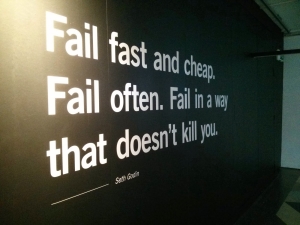 With the end of the year fast approaching, my clients are now focusing like a laser what they would like to accomplish in 2016. Many are finalizing their technology strategy, investing in DevOps practices and tools, committing to Agile transformation, and leveraging the Cloud. All these efforts enable my clients to do two things they couldn’t before: fail fast and pivot.
With the end of the year fast approaching, my clients are now focusing like a laser what they would like to accomplish in 2016. Many are finalizing their technology strategy, investing in DevOps practices and tools, committing to Agile transformation, and leveraging the Cloud. All these efforts enable my clients to do two things they couldn’t before: fail fast and pivot.
What do we mean by fail fast?
When developing new solutions with my clients, we embrace a feedback loop. That is, quickly get something in front of customers, solicit feedback, inspect and adapt, and then decide how to proceed. Most often, we make changes to the product based on customer feedback, but sometimes we terminate a bad idea before more money is spent.
Here, the concept of failure takes on new meaning. With previous non-agile processes, you would create a product over a long period of time and bring it to market fully baked. Then, the market would determine if what you created has value, meets needs, or just plain stinks. Time and money have been needlessly squandered.
There is a better way
I work with clients to redefine failure as simply an iterative test of assumptions. We embrace the inevitable imperfections in our product, and pivot to meet the market need. We do this early and often.
Thomas Edison once said of his mistakes, “I have not failed 10,000 times. I have not failed once. I have succeeded in proving that those 10,000 ways will not work. When I have eliminated the ways that will not work, I will find the way that will work.”
Being agile means your product is never done. I’ve seen countless companies play roulette with ambitious products and initiatives. These efforts either fail to see the light of day, or once launched, crash and burn in the marketplace. Money, morale, and shareholder value go down the toilet.
Working this way also allows us to more easily establish cause and effect. Perhaps a product performs poorly in the market because of a usability or design flaw. Maybe it’s pricing. Or performance. If we make too many changes over too long a period of time, the distance between cause and effect prevents us from responding quickly to feedback.
Save Money While Making Money
In the late 90s and for a while after, I worked for a number of dot-com bubble startups. Absurd valuations, nebulous business models, and venture capital speculation were the name of the game. Companies used other people’s money to produce products of questionable value, usually without profit. It was clearly unsustainable, which is why nearly all of those companies are gone now.
Today, business owners, executives, investors, and shareholders want to see dividends early and often.
Producing a product iteratively allows us to get revenue much earlier than ever before. We can use this revenue, even if minimal, to fund the development of additional features. We add value, then customers respond with more of their money. Another feedback loop.
Challenge Questions for Business Leaders
- Does your process allow you to quickly and easily implement and test new features in the market?
- Can you quickly isolate which feature changes contribute to success and failure?
- How fast can you incorporate customer feedback into your next release?
© 2015 Mark Richman. All Rights Reserved.